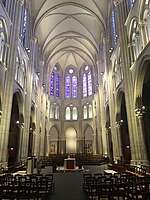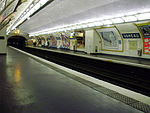Chapel of Our Lady of the Miraculous Medal

The Chapel of Our Lady of Graces of the Miraculous Medal, or more simply "Chapel of Our Lady of the Miraculous Medal", in 140 Rue du Bac, Paris, France, is the chapel where the Blessed Virgin Mary appeared to Catherine Labouré in 1830 and requested the creation of the medal that came to be known as the "Miraculous Medal". The chapel was part of the mother house of the religious congregation of the Daughters of Charity of Saint Vincent de Paul. Catherine Labouré was a seminary sister (novice) there when she witnessed the Marian apparitions.The chapel is more commonly referred to by its address, "140 rue du Bac", or even simply the street on which it is located, Rue du Bac, Paris.
Excerpt from the Wikipedia article Chapel of Our Lady of the Miraculous Medal (License: CC BY-SA 3.0, Authors, Images).Chapel of Our Lady of the Miraculous Medal
Rue du Bac, Paris 7th Arrondissement (Paris)
Geographical coordinates (GPS) Address Nearby Places Show on map
Geographical coordinates (GPS)
| Latitude | Longitude |
|---|---|
| N 48.850974 ° | E 2.32377 ° |
Address
Maison-mère des Filles de la Charité
Rue du Bac
75007 Paris, 7th Arrondissement (Paris)
Ile-de-France, France
Open on Google Maps








